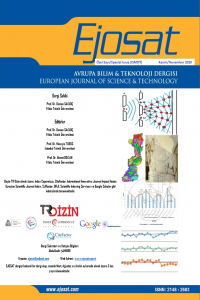Abstract
İletişim, duygu ve düşüncelerin akla uygun şekilde başkalarına aktarılmasıdır. İnsanlar arasında en çok kullanılan iletişim, temeli işitme ve konuşmaya dayalı olan sözlü iletişimdir. Fakat işitme ya da konuşma kaybından kaynaklı olarak engelli bireylerin bu iletişim yöntemini ya kullanmadıkları ya da sınırlı kullanabildikleri görülmektedir. Bu bireyler kendi aralarında çoğunlukla işaret dili, el ya da parmak hareketlerini kullanarak oluşturulan alfabe gibi yöntemler ile iletişim sağlarlar. Yapılan bu çalışmada konuşma ve işitme engelli bireylerin hem kendi aralarında, hem de işaret dili bilmeyen bireylerle daha kolay iletişim kurabilmeleri amacıyla işaret dilini algılayabilen bir sistem geliştirilmiştir. Geliştirilen sistemde kullanılacak olan eldiven üzerine flex (esneklik) sensörler yerleştirilmiştir. Flex sensörler gerilim bölücü devreler ile Arduino’ya bağlanmıştır ve değişen gerilim değerleri alınmıştır. Yapılan sistemde mevcut işaret dili temel alınarak yeni bir işaret dili geliştirilmiştir. Geliştirilen sistemde her parmak ve el hareketleri kombinasyonları ayrı bir kelimeyi temsil etmektedir. Bu kombinasyonlar lojik olarak bilgisayar dilinde lojik 0 ve lojik 1’lerden oluşan sayısal kümelerdir. Geliştirilen sisteme, çalışmada kullanılacak olan kelimelerin karşılık geldiği parmak hareketleri tanıtılmıştır. Kombinasyonların karşılık geldiği kelimeler sistem kütüphanesine aktarılarak depolanmıştır. Yapılan çalışmada günlük hayatta en çok kullanılan kelimeler belirlenmiştir ve test çalışmaları yapılmıştır. Kullanıcı tarafından gerçekleştirilen el ve parmak hareketleri ile yapılan her kombinasyon karşılığında sisteme tanıtılan bir kelime ekran aracılığı ile dışarıya aktarılmıştır.
Supporting Institution
İnönü Üniversitesi BAP
Project Number
FBA-2020-2174
Thanks
Bu projeye desteklerinden dolayı İnönü Üniversitesi BAP kurumuna teşekkür ederiz.
References
- Türk Dil Kurumu Sözlük, Erişim adresi: [Online] https://sozluk.gov.tr/
- Bayır, M. F. (2018). Türk İşaret Dili İncelemesi: İletişim ve Dil Bilgisi. Ulusal Eğitim Akademisi Dergisi, 36
- Ebrahim Al-Ahdal & Nooritawati Md Tahir, (2012), Review in Sign Language Recognition Systems, IEEE Symposium on Computers & Informatics, pp. 52-58.
- Oz, C., & Leu, M. C. (2011). American Sign Language word recognition with a sensory glove using artificial neural networks. Engineering Applications of Artificial Intelligence, 24(7), 1204-1213.
- Yalçin, M., Ilgaz, S., Özkul, G., & Yildiz, Ş. K. (2018, May). Turkish sign language alphabet translator. In 2018 26th Signal Processing and Communications Applications Conference (SIU) (pp. 1-4). IEEE.
- Ceber Y. E., Karacaoğlan E., Uysaf F., Tokmakçi M., "The design of glove that can translate sign language to Turkish language," 2017 Medical Technologies National Congress (TIPTEKNO), Trabzon, 2017, pp. 1-4.
- Chandra, M. M., Rajkumar, S., & Kumar, L. S. (2019, October). Sign Languages to Speech Conversion Prototype using the SVM Classifier. In TENCON 2019-2019 IEEE Region 10 Conference (TENCON) (pp. 1803-1807). IEEE.
- Syed, A., Agasbal, Z. T. H., Melligeri, T., & Gudur, B. (2012). Flex sensor based robotic arm controller using micro controller.
- Badamasi, Y. A. (2014, September). The working principle of an Arduino. In 2014 11th international conference on electronics, computer and computation (ICECCO) (pp. 1-4). IEEE.
Abstract
Communication is the proper transfer of feelings and thoughts to others. The most used communication among people is verbal communication, which is based on hearing and speech. However, it is observed that individuals with disabilities due to hearing or speech loss either do not use this communication method or can use it limitedly. These individuals communicate with each other through methods such as sign language, alphabet created using hand or finger movements. In this study, a system that can perceive sign language has been developed for individuals with speech and hearing impairments in order to communicate more easily with each other and with individuals who do not know sign language. Flex sensors are placed on the glove to be used in the developed system. Flex sensors were connected to Arduino with voltage divider circuits and varying voltage values were taken. In this system, a new sign language was developed based on the existing sign language. In the developed system, each combination of finger and hand gestures represents a separate word. These combinations are logically numerical sets consisting of logic 0 and logic 1 in computer language. Finger movements corresponding to the words to be used in the study were introduced to the developed system. The words corresponding to the combinations have been transferred to the system library and stored. In the study, the most used words in daily life were determined and test studies were conducted. A word introduced to the system in return for each combination made by the hand and finger movements performed by the user was exported via the screen.
Keywords
Project Number
FBA-2020-2174
References
- Türk Dil Kurumu Sözlük, Erişim adresi: [Online] https://sozluk.gov.tr/
- Bayır, M. F. (2018). Türk İşaret Dili İncelemesi: İletişim ve Dil Bilgisi. Ulusal Eğitim Akademisi Dergisi, 36
- Ebrahim Al-Ahdal & Nooritawati Md Tahir, (2012), Review in Sign Language Recognition Systems, IEEE Symposium on Computers & Informatics, pp. 52-58.
- Oz, C., & Leu, M. C. (2011). American Sign Language word recognition with a sensory glove using artificial neural networks. Engineering Applications of Artificial Intelligence, 24(7), 1204-1213.
- Yalçin, M., Ilgaz, S., Özkul, G., & Yildiz, Ş. K. (2018, May). Turkish sign language alphabet translator. In 2018 26th Signal Processing and Communications Applications Conference (SIU) (pp. 1-4). IEEE.
- Ceber Y. E., Karacaoğlan E., Uysaf F., Tokmakçi M., "The design of glove that can translate sign language to Turkish language," 2017 Medical Technologies National Congress (TIPTEKNO), Trabzon, 2017, pp. 1-4.
- Chandra, M. M., Rajkumar, S., & Kumar, L. S. (2019, October). Sign Languages to Speech Conversion Prototype using the SVM Classifier. In TENCON 2019-2019 IEEE Region 10 Conference (TENCON) (pp. 1803-1807). IEEE.
- Syed, A., Agasbal, Z. T. H., Melligeri, T., & Gudur, B. (2012). Flex sensor based robotic arm controller using micro controller.
- Badamasi, Y. A. (2014, September). The working principle of an Arduino. In 2014 11th international conference on electronics, computer and computation (ICECCO) (pp. 1-4). IEEE.
Details
| Primary Language | English |
|---|---|
| Subjects | Engineering |
| Journal Section | Articles |
| Authors | |
| Project Number | FBA-2020-2174 |
| Publication Date | November 30, 2020 |
| Published in Issue | Year 2020 Ejosat Special Issue 2020 (ISMSIT) |


